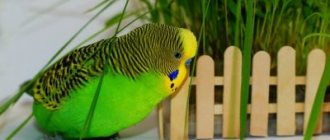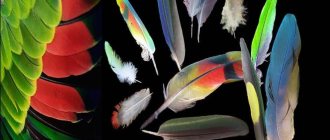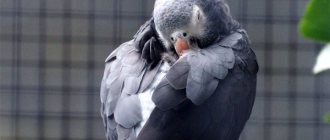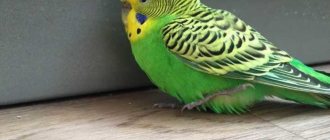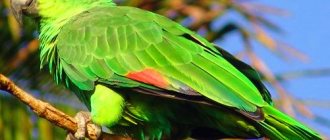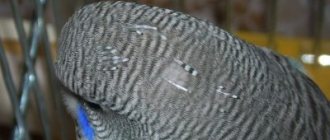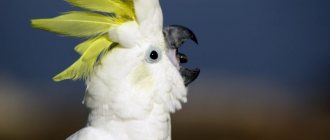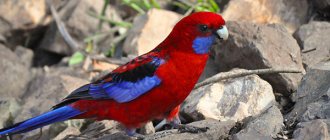Online magazine about parrots
Colors and patterns of budgies
We have translated and compiled for you a guide to the colors and patterns of budgerigars
Look
Popular article
Let's figure out how to choose a mate for a male or female budgie
2
Home › Diseases
Owners of budgerigars often encounter an unpleasant disease represented by self-plucking. Birds pull out feathers for various reasons, which leads to the formation of bare patches of skin.
Typically, this procedure is accompanied by the appearance of an inflammatory process, decreased appetite and decreased immunity. Therefore, it is important to quickly eliminate the causes of such a serious disease.
Let's look at the reasons why a parrot plucks its feathers and what to do about it.
- Disease or not
- Signs
- Reasons for self-plucking Conditions of detention
- Poor nutrition
- Skin irritation
- Frustration
Disease or not
Birds begin to pluck their feathers for different reasons. Experienced ornithologists claim that this problem can occur in all breeds of parrots living in captivity . This is due to the fact that people who buy a pet for the first time do not understand their characteristics well, and therefore do not provide them with optimal care. For various reasons, sellers do not inform buyers about how to properly care for a small pet.
Owners often do not respond to obvious signs that indicate the presence of any diseases, stress or other problems associated not only with the physical, but also with the emotional state of the budgerigar.
Therefore, even after several months of living in an apartment, the bird behaves nervously, bites, screams, runs around the cage, constantly itches and plucks feathers. This is a consequence of extreme stress, poor care or loneliness. Such unpleasant consequences can be avoided with proper care, so it is important to pay a lot of attention to your pet.
Has your parrot been sick?
Not really
Shedding
Molting is a natural physiological process in which birds change their old plumage to new ones. As a rule, parrots molt twice a year - in autumn and spring. During this period, the parrot devotes more time to the hygiene of its plumage. Replacing a feather causes itching, which is why your budgie itches. But if the molting proceeds normally, the parrot is healthy, and the change of plumage occurs evenly. There should be no extensive bald spots or bald spots on the body.
As a rule, due to severe itching, cockatiels and wavy parrots become more irritable. It also happens that birds begin to violently tear out their feathers. You need to worry and take action when wounds, bleeding, non-healing ulcers appear on the body, or if the parrot is becoming very bald.
Shedding
Signs
The main symptoms of self-plucking include:
- apathy of the parrot, which sits on a perch with a ruffled appearance, and also refuses to communicate with the owner or other birds;
- lack of feathers on the chest, belly and wings, and in especially neglected situations the bird plucks feathers on all parts of the body except the head;
- At the bottom of the cage, pulled out feathers are found, and often the bird not only pulls them out, but also bites them, tears them, and trembles;
- if new feathers are pulled out, bleeding wounds appear on the skin.
The wavy plucks out even the smallest and newest feathers, and does this with special frenzy, so large wounds appear and blood vessels are also exposed. This leads to heavy bleeding, so the bird can become infected with other infections.
Parasite infestation
If a budgerigar intensively loses feathers, constantly itches, pulls out feathers, or has bald patches or bald spots on its body, most likely the bird is infected with ectoparasites - scabies mites, feather eaters.
Carefully inspect your pet for fallen feathers. On them you can see traces of the vital activity of parasites. Place a white cloth and a sheet of paper on the bottom of the cage. If small black, gray, or red dots appear, the parrot is infected with a mite.
To prevent the bird from losing its plumage, if the body begins to itch severely, it must be treated immediately using preparations for general and local use (ointments, suspensions, liniments).
The parrot's feathers are falling out
Reasons for self-plucking
The main reasons for self-plucking of birds include:
- lack of communication with relatives or people;
- constant presence in a cage, so the bird does not have the opportunity to satisfy the natural need to fly;
- contamination of the feather, as a result of which the bird feels discomfort, so it tries to get rid of it by tearing it out, and this usually happens with oil or other sticky stains;
- poor quality nutrition or hunger;
- infection with various feather parasites, for example, mites or feather eaters, which crawl on the skin and feathers and therefore cause itching and discomfort in the pet;
- the presence of internal diseases that occur in a latent form, and they are usually associated with an improper diet or feeding the wavy with food from the human table, which negatively affects the metabolism and functioning of the internal organs;
- plucking feathers is often a specific way of showing the bird’s dissatisfaction, which attracts human attention with such actions;
- regular stress associated with the presence of other pets or strangers, as well as stress can occur due to loud music, shouting or sudden switching on of lights at night.
At the first signs of self-plucking, it is necessary to promptly use certain treatment methods, otherwise the process will become a habit, so the bird will constantly pull out new feathers.
If the problem is the presence of parasites, then surgical treatment with special drugs is prescribed. Only products sold in pet stores are selected, as they are non-toxic and safe.
In the photo there is a plucked parrot:
Conditions of detention
Illiterate care often causes self-plucking of wavy plants. Parrots are considered capricious pets that need proper care and attention from humans. If basic requirements are violated, this leads to serious health problems for the pet.
Therefore, it is important to adhere to the following rules:
- long daylight hours of at least 15 hours;
- competent choice of place to install the cage so that it is not exposed to direct sunlight and there are no drafts;
- creating conditions for swimming wavy fish, and this is especially important in the summer;
- regular cleansing of the cage from droppings, husks and other contaminants;
- clean air in the room, as it is prohibited to spray perfumes or aerosols, as well as to smoke near the bird;
- the optimal temperature is within 25 degrees, as well as humidity from 70 to 80 percent.
Particular attention is paid to bathing, since birds often pull out feathers that they cannot clean with their beaks, so it is necessary to provide an opportunity to wash away dirt. If the bird sleeps poorly or often sits in the dark, this leads to stress, irritability and emotional overload, so the parrot plucks feathers to calm down.
Poor nutrition
Both the physical and emotional state of the wavy depends on the diet.
Self-plucking is often associated with the following reasons:
- lack of essential amino acids, which include lysine, cystine or methionine, therefore it is necessary to include protein foods in the diet, for example, boiled eggs, low-fat cottage cheese, yoghurts or minced meat, but do not overdo it with these additives;
- using only grain feed, although the wavy must be additionally given fresh fruits, vegetables and herbs, as well as sprouted grains and protein supplements, so if the diet is too poor, this leads to the appearance of diseases and disruption of the functioning of internal organs, so the bird begins to pluck feathers;
- purchasing low-quality feed sold by weight, since such feed often contains foreign impurities that negatively affect the digestive system and general health of the bird.
Some ornithologists argue that self-plucking is a consequence of pathologies in the thyroid gland, so it is necessary to give your pets beets, cabbage and carrots, since these products stimulate the activity of the gland. But at the same time, the amount of oats and oilseeds, as well as nuts, decreases.
Skin irritation
It occurs for various reasons, which include:
- infection with ticks and feather eaters;
- skin damage by endoparasites, such as Giardia;
- the appearance of fungus.
Itchy skin can be caused by kidney and liver diseases. If skin diseases are treated with ointments, the bird may pluck its feathers because they become sticky. The wavy bird cannot spread its wings, so it often simply rips out its feather. Therefore, if external formulations are used for treatment, they should be applied directly to the skin, without touching the feathers.
Some ornithologists believe that the cause of self-plucking may be severe molting. This also includes hormonal changes. Usually, after the end of molting, the bird stops plucking its feathers on its own.
Frustration
This reason is considered the most complex, as it is associated with the emotional state of the wavy. Parrots in nature live in large flocks and also have a developed psyche. Frustration is a psychogenic disorder associated with stress, anxiety or loneliness. If a bird cannot satisfy its basic psychological or physiological needs, then frustration occurs.
If a bird suffers from loneliness or stress for a long time, this leads to serious consequences for its mental health. This usually causes depression or neurosis. The bird becomes apathetic, depressed and uncommunicative, and also plucks its feathers.
The main causes of frustration include:
- boredom associated with lack of communication with humans or other birds;
- the presence of small children, cats or dogs in the house, which do not give the wavy the opportunity to rest or be in silence;
- stress from the constant appearance of strangers in the apartment;
- planting another parrot that causes negative emotions;
- the owner leaves for a long period, leaving the tamed wavy to strangers;
- loss of a partner;
- incorrect choice of location for the cage, which is constantly located in the shade or next to a heating device.
It is quite difficult to identify problems with the psycho-emotional state, and treatment is based on changing the living conditions of the wavy.
Preliminary inspection
To examine your pet, take the parrot in your arms. If the bird has already gotten comfortable and accustomed to the environment, this will be easy to do. But for a still wild parrot, an examination can cause stress. In this case, act kindly, remembering to talk to your pet in a soothing voice.
Behavior. A healthy bird is active and mobile, reacting cheerfully to sounds. But when the parrot is shaggy, sits on a perch for a long time, and is constantly sleepy, this is not normal. Especially if the pet refuses to eat and does not want to communicate. This behavior indicates the development of the disease.
Completeness. Pay attention to the fatness of the bird! A sick parrot loses up to 1/3 of its body weight (a bird can lose weight in 20-24 hours). Fatness is checked by the development of the pectoral muscles (in a healthy parrot it is elastic and round). But in case of nutritional disorders, especially with cachexia (exhaustion), a pointed edge is easily palpable at the keel bone.
The keel bone (keel) is a longitudinal lower bone with cartilage. It is located in the lower chest area.
Feathers. A healthy parrot has clean, smooth and even feathers. If the parrot has become dirty and disheveled, pick it up and carefully examine it:
- The presence of areas with fallen feathers in the area of the wings and tail indicates stress. This is how feathers fall out during stressful molting (the reasons are cramped cages, rough catching of birds and illiterate transportation).
- The presence of broken feathers, changes in their shape (feathers curl and flake) are a sure sign of skin parasites. Carefully inspect the skin, carefully spreading the feathers - the parasites are visible to the naked eye.
- Dirty feathers in the cloaca area are a sign of gastrointestinal diseases accompanied by diarrhea.
- Contaminated feathers in the area of the crop, chest, and under the wings indicate vomiting, which accompanies infectious diseases of the gastrointestinal tract.
- Plucked feathers in the area of the wings and neck are a sign of a skin disease (eczema).
Leather. To examine and evaluate the bird's skin, gently part the feathers and inspect the skin. A healthy bird has a light pink epidermis. Yellow color indicates obesity or liver disease.
Dehydration of a pet becomes a dangerous situation. To check this, slightly lift the skin of the eyelids (if dehydration is present, the raised skin remains wrinkled and does not return to its original state for some time).
Ears. Carefully inspect your parrot's ear openings for excess secretions or foreign bodies. To view the ears, gently lift the bird's head feathers and inspect the ear openings.
Eyes. Healthy eyes are clear, with a clean cornea. If diseases develop in the bird’s body, the eyes react as follows:
- The third eyelid falls out.
- There is lacrimation.
- The conjunctiva turns red and swells.
Pallor of the conjunctiva indicates that the parrot is becoming anemic. To check your assumption, gently touch the mucous membrane of the eye. With anemia, the eye membranes are soft and pliable. But take into account the age of the bird - in older birds the conjunctiva turns pale.
Nose. When a parrot develops inflammatory diseases of the respiratory system, serous fluid flows from the nose. If the discharge is cloudy in color, there is too much dust in the surrounding air.
Beak. In a healthy bird, the horny surface of the beak is smooth and shiny, without growths, tumors and abscesses.
Mouth. To examine the oral cavity, lightly tap your pet's beak. When examining, pay attention to the condition of the tongue and the color of the mucous membrane. It is also necessary to examine the goiter area (pinch the goiter area with your index finger and thumb and feel it).
If the contents of the goiter are foamy, white, or the consistency of the goiter component is hard, this indicates inflammation. The bird accepts dirty water and food stained with droppings.
Anus. Carefully examine the butt area (before carefully blotting the cloaca with a cotton pad). In a healthy parrot, the area on the butt has no swelling or redness. Otherwise, inflammatory processes occur in the bird.
Paws. The parrot's paws are examined at the end of the preventive measure. Deformation of the claws also indicates illiterate maintenance and a small number of perches. Skin covered with horny scales is a sign that the bird is infected with scabies mites.
If there is a suspicion that the pet is unwell, immediately remove the parrot from other relatives in a quarantine cage. Feed sick birds dry/soft food or sprouted millet. Eliminate fruits and greens from your diet. And hurry up to see the veterinarian!
Treatment methods
To help your parrot not pull out its feathers, it is recommended to spray the feathers with a special bitter composition. Beafar, sold in spray form, is considered effective. The composition contains bitter components that do not harm poultry or humans.
Additionally, you can use the natural antiseptic aloe vera , which not only tastes bitter, but also anesthetizes, stops bleeding, and also softens the skin, relieving irritation.
You can use home remedies, such as making a solution from baking soda. But in addition to using these substances, it is necessary to determine the reason why the bird plucks its feathers.
Down-eaters
The appearance of feather eaters is one of the most likely reasons why parrots pluck their feathers. Small parasites about two mm long most often infect aviary birds, but can settle on a domestic parrot if, for example, the cage was taken out onto an open balcony.
These insects have a gnawing type of mouthparts and eat feathers and keratinized epithelium. Thanks to three pairs of legs with tenacious claws, they easily move around the parrot's body.
The appearance of lice eaters is accompanied by a number of characteristic signs:
- the parrot behaves restlessly, stops playing, eats poorly;
- the bird constantly picks and tries to tear out its feathers, itches, and becomes ruffled;
- upon closer examination, the feathers are dotted with needle-like holes, and clusters of eggs are clearly visible on them.
The yellowish-brown colored insects can be found on the back and under the wings. Female lice eaters often attach their eggs to the down around the bird's cloaca.
The following drugs are used for treatment:
- aerosol insecticides: “Arpalit”, “Clandestine”, “Frontline” (use with caution, following the instructions);
- wormwood or chamomile in powder form is rubbed into the feathers;
- A 1% solution of boric acid is used as an antiseptic.
The cell and all its components must be treated with disinfectants, for example, “Virosan”, “Ecocid S”. You can use boiling water or a 5% iodine solution.
Preventive measures
To prevent self-plucking, it is recommended to use simple preventive measures. To do this, the conditions of detention are changed, the cage is moved to a more suitable place, or a new friend is bought. It is advisable to give your pet a lot of attention so that he does not get bored and does not spend a lot of time alone.
If you buy a new wavy bird, then it is important to make sure that the birds have found a common language, and if they fight or fight for territory, they will have to be seated in different cages.
Knemidocoptic mange (scabies)
This is an extremely dangerous disease that is caused by the scabies mite, a microscopic yellowish-white parasite about 0.3 mm in size. Untimely cleaning of the cage and even dust in the apartment can cause infection with knemidocoptic mange. Accessories purchased at a pet store can be infected with scabies mites or a green twig brought from the street.
Using a gnawing-sucking type of mouthparts, the parasites make passages in the skin of the bird, where they feed on blood and actively reproduce. They affect both bare areas of the body - paws, cere and areas around the eyes, as well as feathered areas. The reason why a budgerigar plucks its feathers is severe itching, which is caused not so much by the movement of parasites as by an allergic reaction to the products of their vital activity.
The symptoms of knemidocoptosis are difficult to confuse with signs of other diseases:
- the horny scales on the paws and cere become deformed and become covered with lumpy growths;
- the bird becomes extremely restless, itches, scratches itchy places with its beak;
- Spongy spots and cracks appear on the surface of the beak.
A parrot in this condition needs complex treatment developed by a specialist. A veterinary ornithologist may prescribe lubricating the affected areas of the body with birch tar, aversectin ointment, the drug “ASD-3”, diluted with vegetable oil in a ratio of 1:5. Frontline insecticidal spray can also be used.
Feeding porridge to adult parrots
Quote “I cook porridge (a mixture of buckwheat, rice and other grains that are on hand) and beans and corn separately in different saucepans - because... Porridge cooks quickly, but beans and corn take a long time. Yes, I almost forgot. I add a little dry oatmeal like rolled oats to the already cooked hot grains - they steam there. From the finished porridge I make pieces about the size of less than a tablespoon and place them on the kitchen board. I do the same with corn beans: I make separate piles of the same size. The board goes into the freezer. When everything has hardened, I break off pieces of porridge and legumes from the board and put them in separate dishes so that they take up less space in the freezer. This way I get pieces:
- fruits and vegetables,
- cereal porridge,
- legumes.
I defrost these pieces and feed them to the macaw. I add a dozen granules to a serving of this porridge. Why don't I mix everything at once? Because in the morning I give him mash with porridge and beans. And in the evening - more fruity. When these components are frozen separately, I can adjust the composition (although this is not necessary. You can mix everything at once). During the day I close the macaw in a cage with this porridge (for 2 hours at about 12 noon and for two hours at about 5 pm) and don’t bother it. When he began to eat it normally, he began to put the mash from the cage on the bait - now it is always available to him... But there is a danger in such mash - it must be changed to fresh no later than after 5 hours (it spoils quickly). - “Quote closed”
What to do if your parrot plucks itself?
If your parrot has plucked, or has begun to pluck, or you suspect that it has begun to pluck, you should immediately contact a avian doctor. Remember that self-plucking (both complete and partial) is always a systemic problem. Those. This is a consequence of the fact that the whole body is sick, and not just one organ. However, even one organ in splendid isolation does not get sick, because the whole organism always suffers; however, you can often hear “the liver hurts”, “the kidneys hurt” - this statement is not true.
The veterinarian prescribes a full initial examination: an X-ray must be taken (I remind you that X-rays for birds are always done in two projections: one picture on the back, the second picture on the side), bacteriological and parasitological analyzes of the droppings must be done. This is a basic kit that helps the veterinarian determine further diagnostic steps. Yes, yes, the doctor needs test data to understand what other tests the parrot needs.
I think readers have already understood that treating self-plucking is a long process, because before the moment self-plucking appears, the bird has been sick for a long time, and therefore the problem cannot be eliminated immediately, even if it is known. And at this moment the owner is tempted to postpone treatment of the bird. The reasoning often goes this way: the bird has been sick for several months, what will change if treatment is delayed for a few more months. This line of thinking is not correct, because the sooner you start treating, the greater the chance of cure, and the sooner your parrot will stop suffering from pain.
Control measures
Self-medication can be harmful, since it is impossible to independently determine the true cause of plucking. The veterinarian prescribes the correct treatment.
After the examination, it is necessary to help the pet get rid of pain - for this you will need the necessary painkillers and anti-inflammatory medications. Based on the results of tests and examination, the veterinarian, depending on the cause of the disease, prescribes antiparasitic drugs or antibiotics. After treatment, the bird’s physical activity and mental balance are restored.
Previous
DiseasesAntibiotics for parrots
Next
DiseasesWhy is the parrot shaking or trembling and what to do
Dermatitis
At the moments when your tamed pets pluck their feathers and scratch their skin until they bleed, they can catch some disease that significantly complicates an already difficult situation.
Many factors can cause this condition. Such as lack of vitamins, dry air, etc.
If your pet finds itself in such an unpleasant situation, it cannot do without timely help from specialists. So don't delay your trip to the vet. Surely he will immediately advise you to do a series of tests on your domesticated parrot.
Tags
budgie plucking why does a parrot plucking budgie so much if a parrot plucks budgies relates molting parrots groom budgie a lot When a parrot plucks a budgie plucks budgies the most budgies so budgies the most budgies can budgies need budgie budgerigars are more active too
wavy corellasymptomstypesof ownersinfectiontotallargemost
Eye diseases
If your pet was completely healthy, but suddenly began to blink or close his eyes frequently, try to examine his eyes closely
Pay special attention to the absence of foreign bodies: husks, sand, fluff
The speck from the eye must be removed by carefully running a clean cotton pad over the surface of the eyeball
It is quite easy to suspect inflammation: if the cockatiel parrot usually has clean and shiny eyes, then during illness they become cloudy and tears flow. The area of skin around the eyes turns red and pus is released.
Eye treatment is as follows: for treatment, use a solution of sodium sulfacyl (take three parts of water for one part of the drug) or furatsilin. Rinsing and instillation are repeated 2-3 times a day, and at night tetracycline eye ointment is placed under the eyelid.
Why do chickens pluck their feathers?
A common question when keeping chickens is “Why do chickens pluck each other’s feathers and eat them?”
A lack of microelements and vitamins can cause feather loss. Also natural processes are seasonal molting and the change of feathers in young individuals. “Chickens eat feathers, what’s missing?” a logical question arises. What to do when chickens pluck each other's feathers?
To identify the reasons for feather pecking both in yourself and in other individuals, it is necessary to analyze the following points:
- Feed. Inadequate feed composition, lack or excess of substances can cause untimely loss of feathers. Lack of sulfur is often accompanied by attempts to pluck feathers.
- Poultry house population is too dense. Aggression in chickens can often manifest itself in the cold season, when the territory for keeping is very limited. Larger individuals may begin to suppress, trying to peck the young. The only way out in such a situation is to resettle the individuals in different rooms.
- Bright light. Light is an essential component for the proper growth and development of young chicks. However, if the lighting is too bright, birds may begin to show aggression towards each other, trying to peck out feathers. More powerful lamps should be replaced or painted blue. This procedure will help moderate aggressive behavior.
- Different breeds. When keeping different breeds of chickens, the beginning of pecking and eating feathers is observed in birds that have lighter plumage in relation to dark chickens. This may be one of the reasons why chickens peck feathers. This is especially noticeable when broilers eat feathers of other breeds.
- Stress. When there is a sudden change in living conditions (temperature, different food, moving to another room), experiencing stress, chickens begin to pull out their feathers.
Chickens pluck each other's feathers
When chickens pluck each other's feathers, they injure their skin. After the individual tastes blood, cannibalism begins to appear. This phenomenon leads to bleeding and death of the individual.
The causes of this pathology may be:
- Genetically fixed mutations. When selecting certain factors in new breeds (high egg production, increased body weight), some signs of cannibalism may become established.
- Frequent food changes. With constant changes in diet, a deficiency of substances necessary for normal life may develop. This factor can trigger the onset of pecking.
- A heterogeneous population in terms of age and size of individuals may play a role in the disadvantage of smaller and weaker individuals. Larger individuals pull out feathers from weak ones and peck small chickens.
- Infection of livestock with parasites and various fungal diseases causes severe discomfort, causing birds to peck at the feather cover and eat feathers.
- Laying hens who are not ready to realize their maternal instinct can begin to peck out the first clutch of eggs, after which they switch to other individuals.
